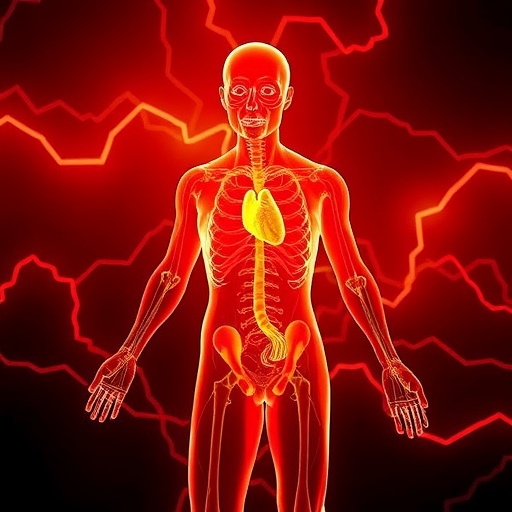
In a groundbreaking advancement poised to reshape our understanding of cardiovascular risk factors, a recent study spearheaded by Nevill, Duncan, and Sandercock delves deep into the complex interplay between body size and atherogenic risk, specifically focusing on the Total Cholesterol to High Density Lipoprotein (TC/HDL) ratio. This ratio serves as a pivotal biomarker for ischemic heart disease (IHD), a leading cause of mortality worldwide. The research employs sophisticated modelling techniques to unravel both direct and indirect associations linking anthropometric measurements with behavioural factors, illuminating pathways that have long eluded comprehensive scientific appraisal.
Cardiovascular diseases remain a global health challenge, with ischemic heart disease occupying a notorious position due to its multifactorial etiology. Traditionally, clinical assessments have relied on singular measures such as cholesterol levels or body mass index (BMI) independently. However, these metrics rarely tell the full story. The study in question pushes beyond conventional boundaries by modeling the synergistic effects of body size and behaviour on the atherogenic risk index, offering a nuanced portrait of cardiovascular vulnerability that may ultimately pave the way for more precise interventions.
At the heart of the investigation lies the atherogenic risk index, operationalized here as the ratio of total cholesterol to HDL cholesterol. This measure encapsulates the delicate balance between ‘bad’ and ‘good’ cholesterol particles within the bloodstream. Individuals presenting elevated TC/HDL ratios frequently exhibit a higher propensity for atherosclerotic plaque formation, a key antecedent to ischemic events. The researchers recognize that while this biomarker is well-established, its relationship with physical and behavioural determinants demands further elucidation, prompting an integrative analytical approach.
.adsslot_l1XRQ6UHIe{ width:728px !important; height:90px !important; }
@media (max-width:1199px) { .adsslot_l1XRQ6UHIe{ width:468px !important; height:60px !important; } }
@media (max-width:767px) { .adsslot_l1XRQ6UHIe{ width:320px !important; height:50px !important; } }
ADVERTISEMENT
Central to the methodology is the application of advanced statistical models capable of parsing out both direct and indirect influences exerted by anthropometric traits such as weight, waist circumference, and body fat distribution. These variables do not operate in isolation; they intersect intricately with lifestyle behaviours including dietary patterns, physical activity levels, and possibly even psychosocial stressors. By constructing a comprehensive model, the study captures these multifaceted interactions, highlighting how certain behaviours may mediate or amplify the impact of body size on lipid profiles.
One of the study’s pivotal revelations concerns the indirect pathways by which behaviour modifies atherogenic risk. For instance, physical inactivity may exacerbate the negative consequences of central adiposity on lipid metabolism, while healthful dietary habits could mitigate this effect despite increased body mass. Such findings challenge the reductionist viewpoint that body size alone determines cardiovascular risk and underscore the necessity of contextually rich assessments in clinical practice.
Moreover, the research underscores the heterogeneity inherent in population-level risk assessments. The strength and nature of associations between anthropometric factors and TC/HDL ratio vary markedly across subgroups, influenced by age, sex, and possibly genetic predispositions. This variability calls for a personalized medicine approach, wherein predictive models are tailored to individual profiles to better forecast ischemic heart disease risk and optimize therapeutic strategies.
The investigative team also contends with the inherent challenges of measurement accuracy within epidemiological studies. Anthropometric data, while readily obtained, suffer from issues such as observer variation and temporal fluctuations. Meanwhile, behavioural factors are often assessed via self-reporting instruments, introducing potential biases. By employing robust modelling techniques and leveraging large, representative cohorts, the study mitigates some of these limitations, enhancing the reliability of its conclusions.
From a mechanistic perspective, the findings illuminate biological pathways through which body composition influences lipid homeostasis. Excess adiposity, particularly visceral fat accumulation, triggers a cascade of metabolic disturbances including insulin resistance, systemic inflammation, and dyslipidemia. These processes collectively contribute to the elevation of the TC/HDL ratio, affirming the importance of addressing central obesity in cardiovascular prevention efforts.
In addition to anthropometry, behavioural modifications emerge as critical modulators of atherogenic risk. The study validates the protective roles of sustained physical activity and balanced nutrition, which not only directly influence lipid concentrations but also interact with body size parameters. This dual impact accentuates the potential of lifestyle interventions to attenuate risk even among individuals classified as overweight or obese.
Importantly, the research calls attention to the limitations of BMI as a singular indicator of cardiometabolic health. While convenient, BMI cannot distinguish between fat and lean mass or discriminate fat distribution patterns that differentially affect atherogenic profiles. Therefore, integrating multiple anthropometric measures within predictive models offers superior granularity and predictive power concerning ischemic heart disease risk.
Furthermore, the study’s modelling framework sets a precedent for future investigations seeking to decouple complex causal relationships in cardiovascular epidemiology. By embracing multi-level analytical strategies, researchers can better capture feedback loops and mediating factors, advancing beyond correlation toward a clearer understanding of causality. This methodological innovation holds promise for refining risk stratification and bolstering preventative cardiology.
The clinical ramifications of the study are profound. Healthcare practitioners may benefit from adopting composite risk assessments that incorporate both anthropometric indices and behavioural insights. Tailored counselling and interventions shaped by such data can enhance patient engagement, adherence, and ultimately, health outcomes. The prospect of individualized risk profiling rooted in nuanced models heralds a paradigm shift in cardiovascular medicine.
Public health policies also stand to gain from these insights, as the integration of behavioural determinants into risk models dovetails with initiatives to promote active lifestyles and dietary improvements. Targeted campaigns addressing both physical and behavioural risk factors are likely to yield more substantial reductions in ischemic heart disease incidence than isolated interventions centered solely on weight management.
Intriguingly, the study invites reflection on the socio-environmental contexts that underpin behavioural patterns and anthropometric trends. Factors such as urbanization, socioeconomic status, and cultural norms may indirectly shape atherogenic risk via their influence on lifestyle choices and body composition. Future research inspired by this work may profitably explore such dimensions, extending the scope of cardiovascular risk modeling.
In conclusion, the research by Nevill, Duncan, and Sandercock epitomizes the evolution of cardiovascular risk assessment from simplistic measures toward integrative, dynamic models capturing the full spectrum of anthropometric and behavioural determinants. By elucidating the nuanced pathways linking body size and lifestyle factors to the atherogenic risk index, the study provides a vital foundation for improving prediction, prevention, and ultimately, patient survival in ischemic heart disease.
Subject of Research: Association between body size and atherogenic risk index (Total Cholesterol/High Density Lipoprotein ratio) linked to ischemic heart disease.
Article Title: Modelling the direct and indirect associations between anthropometric and behavioural factors when predicting atherogenic risk index (TC/HDL-C) ratio.
Article References:
Nevill, A.M., Duncan, M.J. & Sandercock, G. Modelling the direct and indirect associations between anthropometric and behavioural factors when predicting atherogenic risk index (TC/HDL-C) ratio. Int J Obes (2025). https://doi.org/10.1038/s41366-025-01835-0
Image Credits: AI Generated
DOI: https://doi.org/10.1038/s41366-025-01835-0
Tags: anthropometric measurements and heart healthatherogenic risk factorsbehavioral influences on heart diseasebody size and cardiovascular healthcardiovascular risk modeling techniquescholesterol levels and BMI relationshipglobal health challenges in cardiovascular diseaseinnovative research in cardiovascular risk assessmentischemic heart disease biomarkersmultifactorial etiology of heart diseaseprecise cardiovascular interventionstotal cholesterol to HDL ratio



